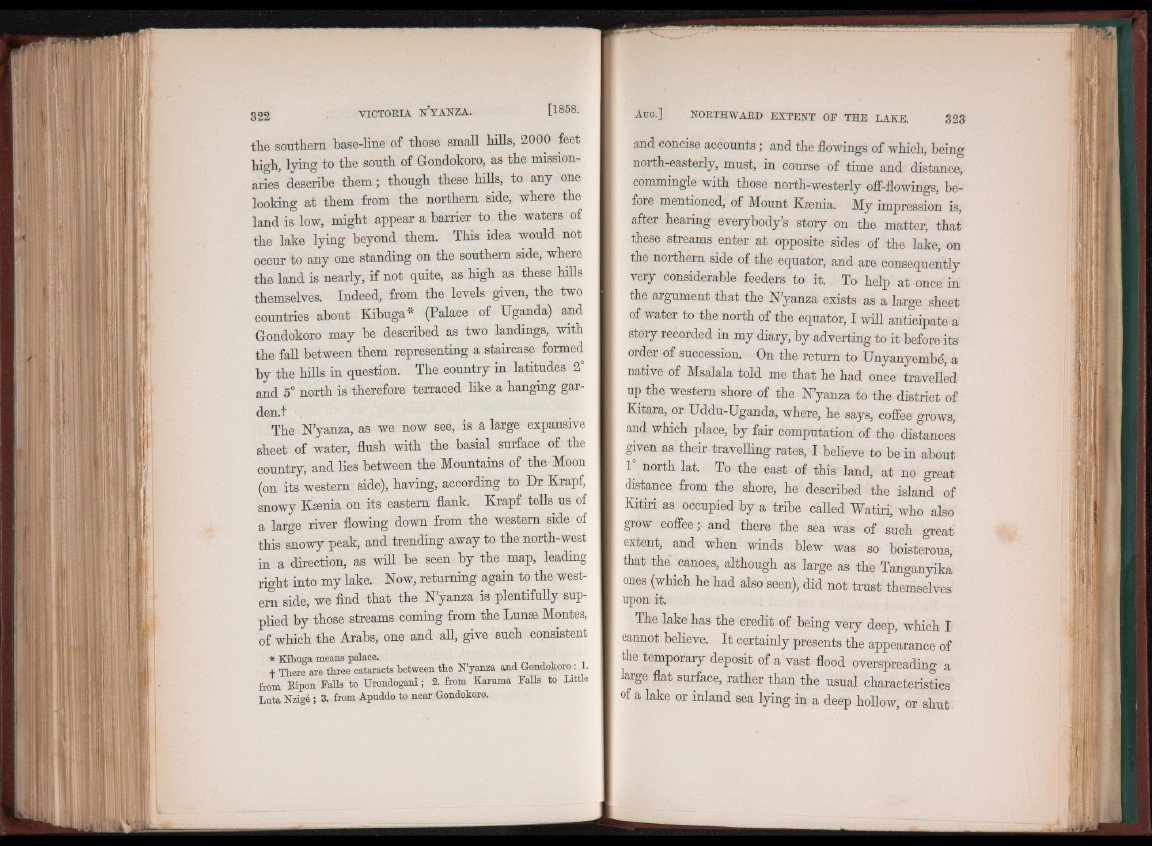
the southern hase-line of those small hills, 2000 feet
high, ly in g to the south of G-ondokoro, as the missionaries
describe them; though these hills, to any one
looking at them from the northern side, where the
land is low, might appear a harrier to the waters of
the lake lying beyond them. This idea would not
occur to any one standing on the southern side, where
the land is nearly, if not quite, as high as these hills
themselves. Indeed, from the levels given, the two
countries about Kibuga* (Palace of Uganda) and
Gondokoro may be described as two landings, with
the fall between them representing a staircase formed
by the hills in question. The country in latitudes 2°
and 5° north is therefore terraced like a hanging garden.!
.
The N’yanza, as we now see, is a large expansive
sheet of water, flush with the basial surface of the
country, and lies between the Mountains of the Moon
(on its western side), having, according to Dr Krapf,
snowy Ksenia on its eastern flank. Krapf tells us of
a large river flowing down from the western side of
this snowy peak, and trending away to the north-west
in a direction, as will be seen by the map, leading
right into my lake. Now, returning again to the western
side, we find that the N’yanza is plentifully supplied
by those streams coming from the Lunse Montes,
of which the Arabs, one and all, give such consistent
* Kibuga means palace. G _
+ There are three cataracts between the N’yanza and Gondokoro: 1.
from Ripon Falls to Uron<logani; 2. from Karuma Falls to Little
Luta Nzige; 3. from Apuddo to near Gondokoro.
and concise accounts; and the flowings of which, being
north-easterly, must, in course of time and distance,
commingle with those north-westerly off-flo wings, before
mentioned, of Mount Ksenia. My impression is,
after hearing everybody’s story on the matter, that
these streams enter at opposite sides of the lake, on
the northern side of the equator, and are consequently
veiy considerable feeders to it. To help at once in
the argument that the N’yanza exists as a large sheet
of water to the north of the equator, I will anticipate a
story recorded in my diary, by adverting to it before its
order of succession. On the return to Unyanyembb, a
native of Msalala told me that he had once travelled
up the western shore of the N’yanza to the district of
Kitara, or Uddu-Uganda, where, he says, coffee grows,
and which place, by fair computation of the distances
given as their travelling rates, I believe to be in about
1 north lat. To the east of this land, at no great
distance from the shore, he described the island of
Kitiri as occupied by a tribe called Watiri, who also
grow coffee; and there the sea was of such great
extent, and when winds blew was so boisterous,
that the canoes, although as large as the Tanganyika
ones (which he had also seen), did not trust themselves
upon it.
The lake has the credit of being very deep, which I
cannot believe. It certainly presents the appearance of
the temporary deposit of a vast flood overspreading a
large flat surface, rather than the usual characteristics
of a lake or inland sea lying in a deep hollow, or shut